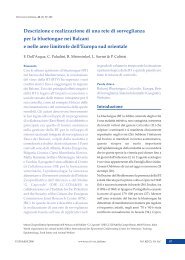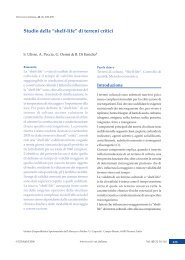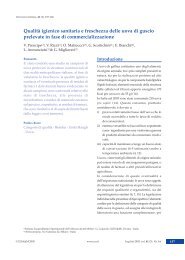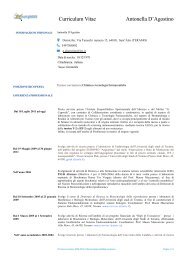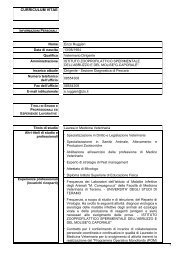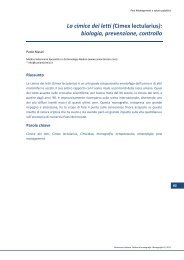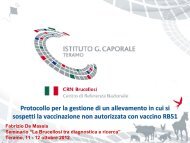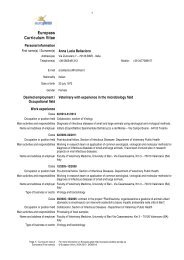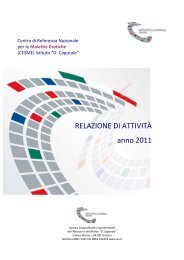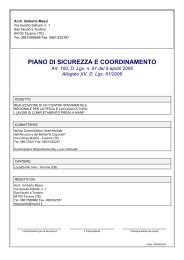Science and technology foresight: a provocative tool for contending ...
Science and technology foresight: a provocative tool for contending ...
Science and technology foresight: a provocative tool for contending ...
You also want an ePaper? Increase the reach of your titles
YUMPU automatically turns print PDFs into web optimized ePapers that Google loves.
<strong>Science</strong> <strong>and</strong> <strong>technology</strong> <strong><strong>for</strong>esight</strong>: a <strong>provocative</strong> <strong>tool</strong> <strong>for</strong> <strong>contending</strong><br />
with future challenges in food safety <strong>and</strong> public veterinary medicine<br />
Jack E. Smith<br />
Foresight planning focuses on a long-term<br />
planning horizon of between five <strong>and</strong> twentyfive<br />
years <strong>and</strong> aims to explore options <strong>and</strong><br />
possibilities among a wide range of future<br />
scenarios.<br />
Creating challenge questions<br />
A <strong><strong>for</strong>esight</strong> exercise typically targets one issue<br />
or problem <strong>and</strong> examines a number of possible<br />
futures, or scenarios, that might arise from it.<br />
A multi-disciplinary team of thinkers is<br />
assembled to tackle the issue, usually through<br />
a series of workshops, panels or conferences.<br />
The team, over time <strong>and</strong> in a structured<br />
process, shares current knowledge of emerging<br />
research, ideas <strong>and</strong> trends to first construct a<br />
set of ‘challenge questions’ <strong>and</strong> then develop<br />
multiple, plausible scenarios, describing<br />
alternate future states. The team can then look<br />
<strong>for</strong>ward <strong>and</strong> back between the present <strong>and</strong><br />
future states to identify likely issues <strong>and</strong><br />
developments that would contribute to each<br />
future scenario.<br />
For example, a ten-year <strong>for</strong>ward scenario that<br />
anticipates greater ecological damage from<br />
unrestricted emissions because of a failure to<br />
manage automobile efficiencies <strong>and</strong> other<br />
atmospheric pollutants could pose a question<br />
<strong>for</strong> back-casting: what preparations in the<br />
period 2005-2010 would have been necessary<br />
to avoid the situation being experienced in the<br />
2015 time period, <strong>and</strong> what advice would the<br />
team wish to give to policy makers to mitigate<br />
the most negative impacts of this scenario<br />
given its plausibility? A <strong><strong>for</strong>esight</strong> exercise<br />
might yield up to ten different scenarios of this<br />
nature <strong>for</strong> the future, some positive or hopeful,<br />
some negative or subject to major uncertainties<br />
– each dependent on triggers <strong>and</strong> developments<br />
that might plausibly come to pass over<br />
the time horizon of the exercise.<br />
In the course of a <strong><strong>for</strong>esight</strong> exercise, other <strong>tool</strong>s<br />
may also be employed or incorporated into the<br />
scenario planning. These <strong>tool</strong>s can include<br />
literature reviews, <strong>technology</strong> mapping, web<br />
surveys, Delphi iterative issue polls <strong>and</strong><br />
challenge dialogues.<br />
Table V lists the main ‘challenge questions’<br />
that were developed by the project team<br />
following the discussion by the East Lansing<br />
Group <strong>for</strong> the three subsequent meetings held<br />
in Calgary, Minneapolis <strong>and</strong> Ottawa later in<br />
2005.<br />
Scenario parameters<br />
A crucial stage of the <strong><strong>for</strong>esight</strong> process is<br />
reducing the list of drivers to those that will be<br />
used to frame the scenarios. This is a<br />
challenging process in itself as participants<br />
must weigh many factors <strong>and</strong> settle upon<br />
those they believe will really make the<br />
difference between heading in one direction,<br />
which becomes the preferred or normative<br />
scenario, <strong>and</strong> having to cope with three other<br />
very different options, all of which may have<br />
significant associated problems.<br />
In the case of the animal health group, the<br />
choice evolved into a discussion of how<br />
important both S&T <strong>and</strong> public<br />
communications would be in the future <strong>and</strong><br />
what strategies would be necessary to realise<br />
the preferred option, even if one might have to<br />
experience some of the effects of the other<br />
options along the way to success. The story of<br />
these strategies <strong>and</strong> their application to the<br />
future of animal health management is<br />
discussed by Willis in this volume (7). The<br />
scenario parameters are presented in Figure 4.<br />
Conclusion <strong>and</strong> lessons learned<br />
Foresight should be seen as a useful learning<br />
<strong>tool</strong> <strong>for</strong> policy researchers, as a <strong>for</strong>ward<br />
planning <strong>and</strong> exploration asset <strong>for</strong> policy<br />
advisors <strong>and</strong> as a context setter <strong>for</strong> policy<br />
makers. By identifying early alerts <strong>and</strong><br />
emergent developments, <strong><strong>for</strong>esight</strong> can provide<br />
the agility required to enhance the resilience of<br />
policy framing, <strong>and</strong> can exp<strong>and</strong> the range <strong>and</strong><br />
robustness of policy options.<br />
244 Vol. 43 (2), Vet Ital www.izs.it/vet_italiana © IZS A&M 2007




